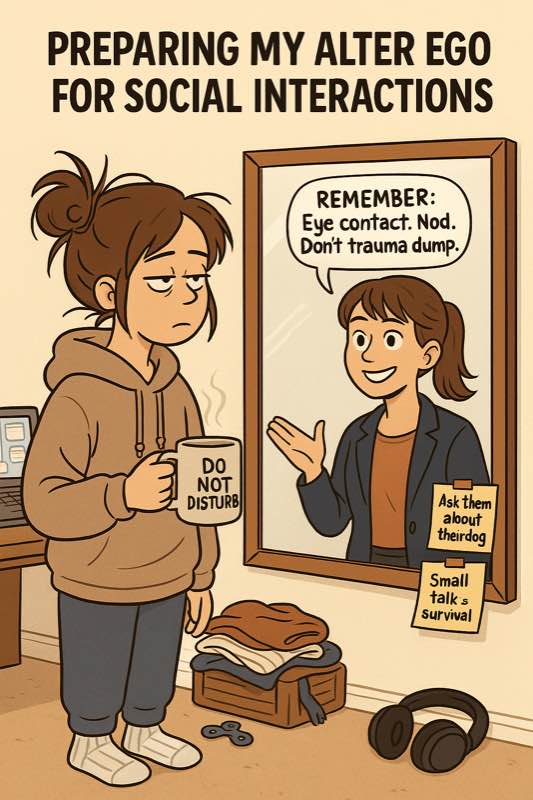ADHD Symptoms in Adults: Signs, Screens & Next Steps
Adult ADHD rarely looks like school‑age hyperactivity. More often it shows up as time blindness, chronic disorganization, task initiation trouble, and emotional impulsivity that disrupt work, studies, and relationships. If these patterns persist across settings and interfere with daily life, they may indicate ADHD.
Adult ADHD evaluation typically includes a symptom review plus evidence of day‑to‑day impairment across settings. When symptoms substantially limit major life activities like concentrating, learning, working, or self‑management, ADHD can be diagnosed and treated.
You can start with a comprehensive self-assessment to organize your thoughts before meeting a professional.

What Adult ADHD Actually Looks Like
Clinically, adults present with a mix of inattentive and impulsive symptoms. Hyperactivity is often internal (restlessness) rather than obvious movement. Below is a snapshot that maps symptom domains to daily‑life examples.
How Common Is Adult ADHD?
Recent U.S. estimates suggest about 6.0% of adults report a current ADHD diagnosis, and over half received their diagnosis in adulthood. These numbers highlight under‑recognition earlier in life and the value of reassessment when impairments persist.
The Hidden Nature of Adult ADHD
Why Adult ADHD Goes Unrecognized
Masking and Compensation
Adults develop coping strategies that hide symptoms, making ADHD less obvious to others and sometimes to themselves.
Changed Expectations
Adult life requires more self,direction and organization, revealing executive function deficits that weren't problematic in structured childhood environments.
Gender Differences
Women and girls are often underdiagnosed because they present with inattentive symptoms rather than disruptive hyperactive behaviors.
Misattribution to Other Causes
Symptoms are often blamed on stress, anxiety, depression, or personality traits rather than being recognized as ADHD.
Core Symptom Categories in Adults
Inattentive Symptoms
| Option | Description |
|---|---|
| Sustained Attention Problems | Difficulty maintaining focus during meetings, reading, or detailed work tasks despite genuine effort to concentrate |
| Detail,Oriented Task Struggles | Making careless errors in work, overlooking important details, difficulty with tasks requiring careful attention to detail |
| Listening and Following Through | Appearing not to listen when spoken to directly, struggling to follow through on instructions or commitments |
| Organization and Planning | Difficulty organizing tasks and activities, trouble managing time and meeting deadlines, avoiding complex projects |
| Memory and Daily Tasks | Frequently losing important items, forgetting daily activities, appointments, or obligations despite good intentions |
| External Distraction | Easily distracted by unrelated thoughts or environmental stimuli, difficulty filtering out irrelevant information |
Hyperactive,Impulsive Symptoms
| Option | Description |
|---|---|
| Internal Restlessness | Feeling driven by a motor, difficulty sitting still during meetings or leisure activities, need for constant movement |
| Verbal Impulsivity | Interrupting conversations, finishing others' sentences, difficulty waiting for turns in discussions |
| Decision,Making Impulsivity | Making important decisions without adequate consideration, impulsive purchases, sudden job or relationship changes |
| Impatience and Waiting | Difficulty waiting in lines, becoming frustrated with delays, rushing through tasks to move on to the next thing |
| Risk,Taking Behaviors | Engaging in potentially harmful activities, driving aggressively, making impulsive financial decisions |
| Emotional Dysregulation | Quick temper, emotional outbursts disproportionate to triggers, difficulty managing frustration and disappointment |

Self‑Checks and Screening Tools
Short questionnaires help determine whether a full evaluation is warranted. Use them as starting points,not final answers.
Understanding Screening Limitations
What Screening Can and Cannot Do
Risk Identification Only
Positive screens indicate higher likelihood of ADHD and suggest professional evaluation would be beneficial, but cannot diagnose.
Self,Report Limitations
Screening relies on self,awareness and honest reporting, which can be affected by insight, mood, or social desirability bias.
Context Missing
Screens don't capture childhood history, functional impairment severity, or rule out other conditions with similar symptoms.
Professional Interpretation Needed
Results require clinical interpretation considering individual circumstances, medical history, and differential diagnosis.

Conditions That Can Mimic or Worsen ADHD
Thorough evaluation rules out other causes of inattention, restlessness, or memory issues and documents what's co‑occurring.
When to Seek Professional Evaluation
Consider professional ADHD assessment if you answer "yes" to most of these questions:
Signs Professional Evaluation is Needed
Persistent Cross,Setting Impairment
Symptoms cause problems at work or school AND in personal relationships AND in daily life management,not just one area.
Childhood History Present
You can identify similar attention, organization, or impulse control issues dating back to your school years, even if not recognized.
Functional Limitations
Symptoms meaningfully interfere with your ability to work effectively, maintain relationships, or manage daily responsibilities.
Other Strategies Haven't Helped
You've tried organizational systems, therapy for anxiety or depression, stress management, but core issues remain.
Safety or Finance Concerns
Attention problems have led to accidents, financial difficulties, or other safety concerns in your life.
You can start with a comprehensive self-assessment to organize your thoughts before meeting a professional.
What a Proper Adult ADHD Assessment Includes
A comprehensive ADHD evaluation goes far beyond screening questionnaires to provide accurate diagnosis and treatment planning.
Components of Professional Evaluation
| Option | Description |
|---|---|
| Clinical Interview | Detailed discussion of current symptoms, childhood history, family history, and functional impairment across life areas |
| Standardized Rating Scales | Validated questionnaires completed by you and potentially family members or close friends who know you well |
| Medical and Psychiatric Screening | Review of medical conditions, medications, sleep patterns, substance use, and mental health history |
| Differential Diagnosis | Careful evaluation to rule out anxiety, depression, learning disabilities, and other conditions that can mimic ADHD |
| Cognitive Testing | Some evaluators include tests of attention, memory, and executive function to provide additional objective data |
| Functional Impact Assessment | Documentation of how symptoms affect work performance, relationships, daily living skills, and quality of life |
Understanding Diagnostic Criteria
DSM,5 Criteria for Adult ADHD Diagnosis
Symptom Count and Severity
At least 5 symptoms of inattention and/or hyperactivity,impulsivity that are inconsistent with developmental level.
Childhood Onset
Several symptoms must have been present before age 12, even if not formally diagnosed at the time.
Cross,Setting Impairment
Symptoms must be present in two or more settings (work, home, social situations) and cause significant impairment.
Functional Impact
Symptoms must significantly interfere with or reduce quality of functioning in social, academic, or occupational areas.
Rule Out Other Conditions
Symptoms are not better explained by another mental disorder, medical condition, or substance use.

Next Steps After Screening
Your path forward depends on your screening results and current life circumstances:
If Screening Suggests Possible ADHD
Steps After Positive Screening Results
Document Impact Examples
Collect specific examples of how symptoms impact your daily life, work performance, and relationships over time.
Gather Childhood Evidence
Look for old report cards, talk to family members, or recall specific examples of attention/behavior issues from childhood.
Find Qualified Professional
Seek psychiatrists, psychologists, or neuropsychologists with specific experience in adult ADHD assessment.
Prepare for Assessment
Bring screening results, specific examples of impairment, medical history, and questions about treatment options.
If Results Are Unclear or Negative
When Screening Results Are Inconclusive
Explore Other Explanations
Consider whether sleep issues, stress, anxiety, depression, or medical conditions might explain your symptoms.
Track Symptoms Over Time
Keep a brief daily log of attention problems, organization challenges, and their impact for several weeks.
Try Evidence,Based Strategies
Implement organization systems, stress management, sleep hygiene while monitoring if core symptoms improve.
Consider Professional Consultation
If symptoms persist despite addressing other factors, consider professional evaluation even with negative screening.
Common Questions About Adult ADHD Symptoms
Can ADHD symptoms develop in adulthood?
While ADHD symptoms must begin in childhood according to diagnostic criteria, they may not become problematic or noticeable until adult responsibilities exceed coping abilities. Many adults are diagnosed when increased demands reveal existing executive function deficits.
Why do ADHD symptoms seem worse during certain periods?
ADHD symptoms can fluctuate based on stress levels, sleep quality, hormonal changes, life transitions, and environmental demands. Symptoms often become more apparent during periods of high stress or major life changes.
How do ADHD symptoms differ between men and women?
Women are more likely to present with inattentive symptoms (daydreaming, disorganization) rather than hyperactive behaviors, leading to underdiagnosis. They may also experience symptom changes related to hormonal fluctuations during menstruation, pregnancy, and menopause.
Practical Next Steps
Your Action Plan
Start with Self,Assessment
Complete our comprehensive ADHD screening to organize your thoughts and identify potential concerns.
Document Real,World Impact
Collect examples of missed deadlines, performance reviews, relationship feedback, or daily living challenges.
Schedule Professional Assessment
If screening suggests ADHD, book a comprehensive evaluation with a qualified mental health professional.
Discuss Treatment Options
Work with your provider to develop a multimodal plan including education, skills training, accommodations, and when appropriate, medication.
You can start with a comprehensive self-assessment to organize your thoughts before meeting a professional.
Key Takeaways
Adult ADHD presents differently than childhood ADHD, often manifesting as executive dysfunction, emotional dysregulation, and internal restlessness rather than obvious hyperactivity. Understanding these presentations is crucial for recognition and appropriate treatment.
Remember: , Screening is just the beginning,comprehensive evaluation is needed for diagnosis , Symptoms must be persistent and cross,situational,not just recent or situational , Many conditions can mimic ADHD,proper assessment rules out other explanations , Effective treatments exist when ADHD is accurately diagnosed and understood
If you recognize persistent patterns of inattention, hyperactivity, or impulsivity that interfere with your daily functioning, taking a validated screening test is a reasonable first step toward understanding and addressing these challenges.
This article provides educational information only and is not a substitute for professional medical advice. For personalized guidance about ADHD evaluation and treatment, consult with a qualified healthcare provider.
